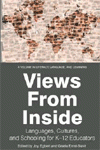
Views from Inside
Languages, Cultures, and Schooling for K‐12 Educators
Edited by:
Joy Egbert, Washington State University
Gisela Ernst‐Slavit, Washington State University
A volume in the series: Literacy, Language and Learning. Editor(s): Claudia Finkbeiner, Universitaet Kassel. Wen Ma, Le Moyne College.
Published 2017
The goal of this text is to help teachers in diverse classrooms understand the importance of students’ culture, languages, and schooling experiences to curriculum, assessment, and student achievement. Readers will learn about aspects of specific cultures and languages that are important to their understanding of their students, and they will discover that cultures that are often considered similar may not be so (and why they aren't). Finally, the text focuses on how teachers can integrate languages and cultures into classrooms and how to account for students' backgrounds and funds of knowledge when devising tasks.
The text starts with an introduction to language and culture that presents a research‐based explanation of why these concepts are important for teachers to understand (Chapter 1). Then, the middle 28 chapters each address one country/culture. Each chapter starts with a school scenario in the US. Part 2 of each chapter includes evidence‐based demographic and background data on the country, including historical events that may have an impact on our students and their families. Part 3 includes a look at education, schooling, and culture, including famous people, contributions to the world, personal characteristics, important religious information, focal customs, and other aspects that are important to cultural insiders. Part 4 is about language and literacy traditions and how they relate to the culture, a number of words that teachers can learn (e.g., yes, no, thank you, please, hello), how the language is different from and similar to English, and what those differences and similarities might mean for English language learners from that culture. Part 5 comprises advice, resources, and ideas for teachers (for example, if it is an oral culture, the teacher might consider working with students on oral storytelling before transitioning to written stories, or incorporate both using technology). Each chapter also contains recommended readings and resources and short exercises that extend the chapter information. The final chapter presents parting notes for teachers and additional suggestions for addressing diversity.
CONTENTS
Dedications and Acknowledgments. Preface. SECTION 1: INTRODUCTION TO CULTURE AND LANGUAGE. Understanding Culture and Language in Education, Gisela Ernst‐Slavit. SECTION 2: ARAB AND PERSIAN REGION. The Gulf Region, Abir El Shaban, Rana Raddawi and Jacqueline Tanner. Middle East, Raed Alsawaier. Islamic Republic of Iran/Persia, Seyed Abdollah Shahrokni. SECTION 3: NORTH/CENTRAL AMERICAN REGION. Mexico, Brenda Barrio and Maria Morales. Puerto Rico, Gladys R. Capella Noya and Elsie Candelaria Sosa. Nicaragua, Desirée Pallais and Ilana Umansky. SECTION 4: SOUTH AMERICAN REGION. Argentina, Sandra Mercuri and Sandra Musanti. Brazil, Eliane Rubinstein‐Avila and Adriana Picoral. Peru, Gisela Ernst-Slavit. SECTION 5: SOUTHEAST ASIAN REGION. Vietnam, Eric Ambroso and Nguyễn Thị Thu Điệp. India, Rani Muthakrishnan and Sreejith Thankappan. Bangladesh, Shampa Biswas, Sayeeda Rahman, and Raihan Sharif. Pakistan, Tariq Akmal and Romella Husain. Philippines, Jeom Ja Yeo. SECTION 6: ASIAN REGION. China, Penny Wang and TingTing Wang. Taiwan, David Herman and Aichia Chang. Japan, Saeun Lee and Leslie Huff. Korea, Hyun‐Gyung Lee and Saeun Lee. SECTION 7: AFRICAN REGION. North Africa, Omran Akasha and Mohamed ElHess. Nigeria, Nathaniel J. Hunsu and Alusola Adesope. The Democratic Republic of the Congo, Kristen Pratt and Rose Lusangi Phambu. Angola, Nicolau N. Manuel and Pamela J. Bettis. SECTION 8: EUROPEAN REGION. Russia, Yuliya Ardasheva and Alexei Kochetov. Ukraine, Nataliia Borysenko and Petro Borysenko. Poland, Justyna Hjeltness. SECTION 9: UNITED STATES. Culture, Language, and Schooling in the United States, Joy Egbert. About the Contributors.
-
Paperback978-1-64113-019-6
Web price: $62.04 (Reg. 72.99)
-
Hardcover978-1-64113-020-2
Web price: $89.24 (Reg. 104.99)
- eBook978-1-64113-021-9

- LAN010000 - LANGUAGE ARTS & DISCIPLINES: Literacy
- EDU007000 - EDUCATION: Curricula
- EDU037000 - EDUCATION: Research
-
 Authentic Voices
Culturally Responsive Teaching and Learning
Authentic Voices
Culturally Responsive Teaching and Learning
-
 Chinese Education from the Perspectives of American Educators
Chinese Education from the Perspectives of American Educators
-
 Collaborative Learning in a Global World
Collaborative Learning in a Global World
-
 Educational Practices in China, Korea, and the United States
Reflections from a Study Abroad Experience
Educational Practices in China, Korea, and the United States
Reflections from a Study Abroad Experience
-
 Innovative Approaches to Teaching Multilingual Students
Innovative Approaches to Teaching Multilingual Students
-
 Listening to the Voices of Boys
Exploring the Motivation of Primary Boys to Engage in Reading
Listening to the Voices of Boys
Exploring the Motivation of Primary Boys to Engage in Reading
-
 Reconceptualizing Literacy in the New Age of Multiculturalism and Pluralism
2nd Edition
Reconceptualizing Literacy in the New Age of Multiculturalism and Pluralism
2nd Edition

